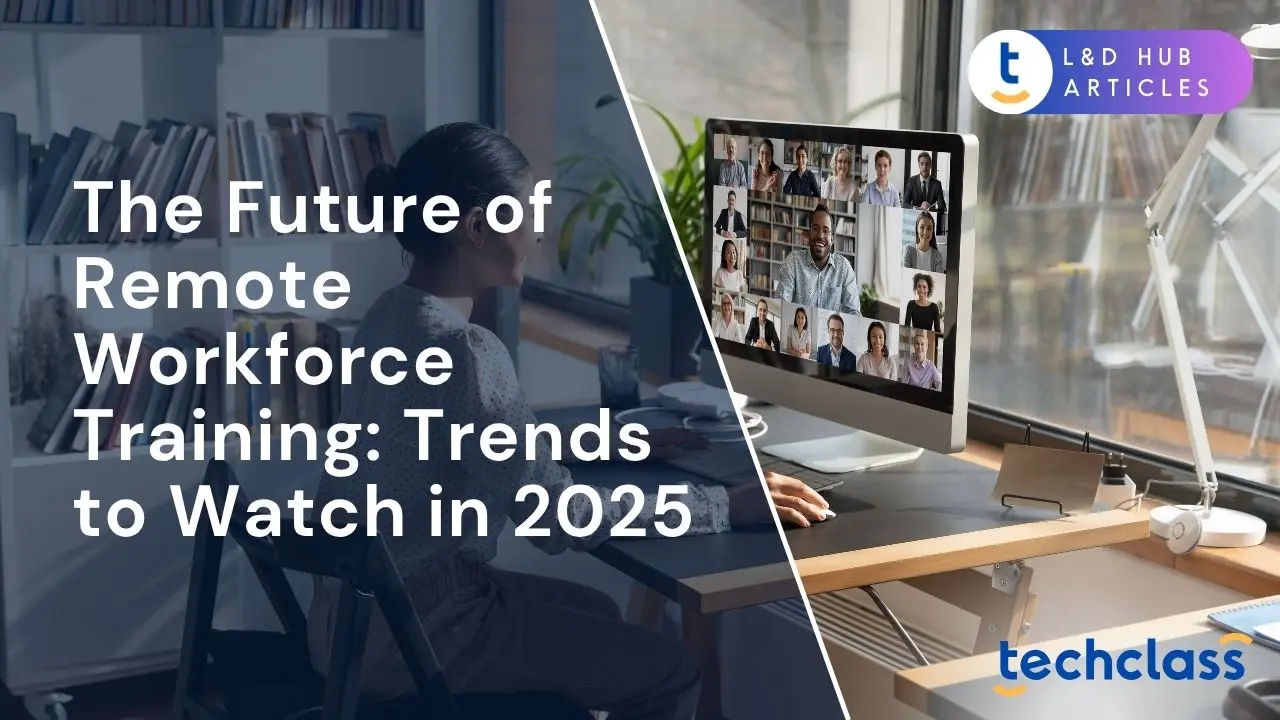
Remote and hybrid work have become permanent fixtures of the modern workplace, forcing organizations to rethink how they train their people. Traditional in-person workshops don’t always work for distributed teams, and employees now expect learning to be as flexible as their work arrangements. In response, companies are leveraging new technology and strategies to keep their workforce skilled, engaged, and adaptable. From artificial intelligence that personalizes learning to virtual reality simulations that provide hands-on practice, a variety of innovations are reshaping employee development.
Below, we explore the key remote workforce training trends to watch in 2025. These trends reflect a shift toward digital, learner-centric training models that overcome distance and keep pace with rapid changes in skills needed.
Hybrid and remote work are now standard practice rather than exceptions, which means training must be designed with off-site participants in mind from the start. In 2025, companies assume a significant portion of their learners will attend virtually. As a result, they are making online learning a core part of training strategy, recording live sessions for later viewing, hosting interactive workshops via video conference, and using cloud-based learning platforms to house materials. The benefits are clear: remote-friendly training can cut travel costs, reach a geographically dispersed workforce, and let employees learn at their own pace. By building every training program to be accessible anywhere, organizations create a flexible, inclusive learning environment. Remote workforce training has truly gone mainstream, enabling businesses to onboard and upskill talent from anywhere with ease.
Advances in artificial intelligence are enabling a new level of personalization in employee training. AI-driven platforms can analyze each learner’s progress and tailor content to their needs. For example, an adaptive system might give extra practice on topics where an employee struggles while letting them skip material they’ve already mastered. This creates a personalized learning path for everyone, so training is neither too easy nor too hard.
AI is also helping with content creation and analytics. Generative AI tools can draft basic training materials, like quiz questions or video scripts, freeing L&D teams to focus on higher-level design. Meanwhile, AI-powered analytics identify skill gaps and predict training needs by crunching data from learner performance. By leveraging AI in these ways, organizations can deliver the right content to the right people at the right time. It’s important to note that human expertise is still vital to guide AI and ensure the learning aligns with real business goals, but used well, AI is a powerful assistant for scaling and customizing remote training.
When employees can’t gather in person, virtual reality (VR) and augmented reality (AR) offer immersive ways to learn by doing. VR can place employees into realistic 3D scenarios where they practice tasks hands-on, for instance, a new technician can virtually step through a machine repair or a manager can rehearse a client presentation in a simulated meeting room. AR overlays digital information on the real world, which is useful for on-the-job guidance (imagine a remote expert’s instructions appearing in a field engineer’s AR glasses as they fix equipment). As VR/AR hardware becomes more affordable and user-friendly, more companies are integrating these tools into training. In fact, studies predict that by 2025 over half of large organizations will be using VR or AR in their learning programs. These technologies make remote training far more engaging and effective by providing interactive, lifelike practice environments, allowing employees to learn by doing in a safe virtual space.
In the age of remote work, attention spans are limited and schedules are busy, so training that fits into small time slots is invaluable. Microlearning, delivering content in bite-sized modules of just a few minutes, has become a popular strategy. Employees can complete a 5-minute tutorial or quiz between meetings and retain more from these focused lessons than from a long lecture. Along with microlearning, companies are embracing on-demand learning. Rather than waiting for a scheduled class, workers can access training whenever a need arises. A remote employee who encounters a new software problem, for example, can immediately watch a short how-to video or read a quick guide to get a solution. This just-in-time approach makes learning a continuous part of the workday. Microlearning and on-demand resources work best when they complement deeper training for complex topics, but they have proven effective in keeping learning continuous without overwhelming people’s time.
Keeping remote trainees engaged is a challenge, and gamification has emerged as a powerful solution. Gamification means incorporating game-like elements into learning, things like point systems, quizzes, badges, levels, and leaderboards, to motivate participants. For example, employees might earn points or badges for completing modules and see their progress on a leaderboard, sparking friendly competition. These reward systems tap into people’s natural motivation to compete and achieve. Gamified training often also includes interactive scenarios or simulations where learners make decisions and solve problems (turning training into something akin to a game). This approach makes learning more fun and immersive, which in turn boosts participation and knowledge retention. When learning feels like a game or challenge, remote employees are more likely to stay focused and complete their training modules instead of tuning out.
One drawback of remote work is the loss of casual, in-person learning, those moments when employees could pick up tips from a colleague or ask a quick question. To fill this gap, organizations are turning to social learning tools that let people share knowledge online. This can include internal forums or chat channels where employees ask questions and experts or peers chime in with answers. Companies also host virtual “lunch and learn” sessions or team-based workshops over video to encourage interaction. Another tactic is assigning group projects or case studies as part of training, so distributed team members can collaborate and learn from each other in real time. Younger employees in particular value these collaborative experiences, and they help build a sense of community. Mentorship has also gone virtual, a new hire might meet regularly via video with a mentor in another location. All of these approaches ensure that even when working apart, employees can learn from colleagues and feel connected through the learning process.
The rapid pace of change in business and technology means employees constantly need to update their skills. Forward-thinking organizations have made continuous upskilling a priority. Instead of treating training as a one-off event, they encourage ongoing learning so that staff can keep pace with new tools and evolving job requirements. This effort goes beyond technical training; just as important are soft skills like communication, leadership, teamwork, and adaptability. These human-centric skills have become even more crucial in remote work environments, where clear communication and self-discipline directly impact team success. Companies are investing in their people by providing access to online course libraries, scheduling regular virtual workshops, and even offering mentorship and coaching programs. The payoff is significant: employees are more engaged and more likely to stay with an employer that actively supports their growth. By closing skill gaps and nurturing soft skills, organizations build a more agile and resilient workforce that can adapt to whatever the future brings.
Training programs in 2025 are increasingly guided by data and analytics to prove their value. Organizations no longer measure success simply by how many employees completed a course; they look at how training affects performance indicators like sales numbers, quality metrics, customer satisfaction, or employee retention. Modern learning platforms provide detailed data that can link a training to real outcomes. For example, if a customer service workshop leads to higher customer satisfaction scores, or a sales course correlates with more deals closed, those metrics demonstrate a clear return on investment for the training effort.
Data also helps L&D teams continuously improve programs. By examining usage patterns and feedback, companies can see which modules people find engaging and which ones have high drop-off rates. They can then refine content or delivery methods accordingly. Analytics might also reveal skill gaps, for instance, showing that certain teams haven’t engaged with new cybersecurity training, allowing managers to target those areas. In essence, a data-driven approach ensures that remote training isn’t just happening, but that it’s effective and aligned with business goals. It gives L&D professionals the evidence they need to secure leadership support by showing that training directly contributes to organizational success.
The future of remote workforce training will be defined by adaptability and a people-centered approach. Organizations that leverage these emerging trends, while keeping employee development at the heart of their strategy, will cultivate teams that are resilient and ready for new challenges. The technology and methods may be evolving, but the goal remains the same: to empower employees to grow and succeed. Companies that create a strong learning culture, invest in continuous upskilling, and embrace innovative tools will have a workforce that is not only highly skilled and productive, but also engaged and loyal. In an era of constant change, a commitment to learning is the best strategy for both employees and businesses to thrive. For employees, opportunities to learn and grow lead to higher engagement and career satisfaction; for organizations, they translate into a stronger talent pipeline and a competitive edge.
Remote training is increasingly digital, personalized, immersive, and designed for flexible, accessible learning through tech like AI, VR, and microlearning.
AI personalizes learning paths, analyzes skill gaps, assists content creation, and provides insights to improve training effectiveness.
VR offers realistic, hands-on virtual scenarios, while AR overlays digital info onto the real world for on-the-job guidance, making remote learning more engaging.
Microlearning delivers short, focused modules that fit into busy schedules, enabling just-in-time learning and better knowledge retention.
Using online forums, virtual workshops, group projects, and mentorship fosters interaction, community, and knowledge sharing among dispersed teams.

.webp)
